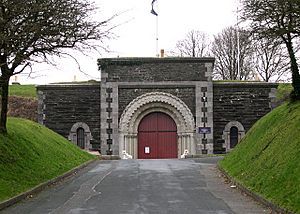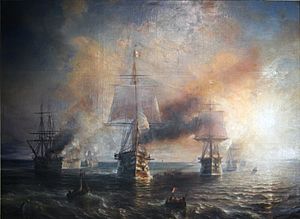Royal Commission on the Defence of the United Kingdom facts for kids

The Royal Commission on the Defence of the United Kingdom was a special group set up in 1859. Its job was to figure out if the United Kingdom could protect itself from an attack by another country. They also had to tell the British Government what needed to be done to make the country safer. People were worried because France was getting stronger in its military and navy. The Prime Minister, Henry Temple, 3rd Viscount Palmerston, was a big supporter of this project. The next year, the Commission suggested building many forts to protect Britain's important weapon factories and navy ports. Many of these forts were built. However, they cost a lot of money and took a long time to finish. People debated if they were even useful in the end.
Contents
Why Britain Needed Defences

In the late 1850s, many people in Britain were very worried that France might try to invade. Big changes had happened in how guns worked, making them much more powerful. Ships were also starting to use steam engines, making them faster and more reliable. The French navy had grown a lot, becoming as strong as the British navy by 1858. These changes made people like Prime Minister Palmerston believe that Britain's coastal defences were not strong enough. They feared that if the Royal Navy (Britain's navy) was busy somewhere else, Napoleon III of France could easily invade.
The Royal Commission's Work
Who Were the Commissioners?
The Commission was made up of seven important people. Six were high-ranking officers from the navy and army, and one was a civilian architect.
- Major-General Sir Henry David Jones (He was the leader)
- Major-General Duncan Alexander Cameron
- Rear Admiral George Augustus Eliot
- Major-General Sir Frederick Abbott, from the British Indian Army
- Captain Astley Cooper Key, from the Royal Navy
- Lieutenant-Colonel John Henry Lefroy, from the Royal Artillery
- James Fergusson
The secretary of the Commission was Major William Jervois. He was a smart military engineer who helped plan fortifications. Even though he wasn't a Commissioner, he had a lot of influence. Captain Cooper Key knew a lot about new naval guns. Lieutenant-Colonel Lefroy was an expert in artillery. James Fergusson was an architect who had also written books about how to protect Britain's coasts.
-
Major-General Sir Frederick Abbott
How They Investigated
The Commission started its work on November 3, 1859. First, they talked to many experts and senior military and navy officers. One expert was Captain Cowper Phipps Coles, who knew a lot about attacking forts from the sea. He got so frustrated by the questions that he had to leave the room twice to calm down! Because of this, the Commission didn't ask him about his new idea for a revolving gun turret.
Another person they interviewed was General John Fox Burgoyne. He believed that protecting the dockyard at Portsmouth was most important. He thought it could be defended by building forts on the Isle of Wight and Portsdown Hill, which is a ridge overlooking Portsmouth. He also thought the coast between Portsmouth and the Thames was at risk and that every small harbour there needed protection. Sir William Armstrong, who designed and made artillery, was asked about the power of new rifled guns. He said his latest guns could break through some old fort designs. However, he thought guns would probably not be able to shoot further than 5 miles (8 kilometers) in the future.
The Commission also visited the places they were discussing. After gathering all this information, they wrote their report. The Commissioners, being experts, seemed to work well together.
The Commission's Report
The Commissioners published their report on February 7, 1860. They decided that Britain's navy, army, and volunteer forces, even all together, were not enough to stop an invasion. They looked at 700 miles (1,127 kilometers) of coastline from the Humber to Penzance that they thought was at risk. They said it was impossible to fortify all of it. So, they suggested that forts should only be built at key points. These were places that an enemy would need to control to launch a full attack.
The report included a detailed plan and cost for each place that needed defences. This included forts that were already being built. It was a huge building plan! The total cost for buying land and building the forts was estimated to be:
| Area | Total cost (in pounds) |
|---|---|
| Plymouth | 3,020,000 |
| Portsmouth | 2,800,000 |
| Pembroke | 765,000 |
| Portland | 630,000 |
| Thames | 180,000 |
| Medway | 450,000 |
| Chatham | 1,350,000 |
| Woolwich | 700,000 |
| Dover | 335,000 |
| Cork | 120,000 |
| Total | 10,350,000 |
They also added £500,000 for weapons for these forts (which turned out to be far too little) and £1,000,000 for special floating batteries (ships with guns). This brought the grand total to £11,850,000. The Commissioners also suggested that volunteer soldiers should be trained to operate the guns in the new forts.
Building the Forts
The government mostly agreed with the report. However, they thought the plan was too big for Parliament to approve. So, they decided to build fewer forts but still try to achieve the main goals for each area. For example, they decided not to build fifteen forts at Plymouth, ten at Pembroke, six at Portsmouth, and four at Chatham. They also got rid of the idea for floating batteries. This saved £3,930,000.
Prime Minister Palmerston presented the Fortification Bill to the House of Commons on July 23, 1860. Many people were surprised by the huge cost. Some people were against it because they didn't believe France was a real threat. Others thought Britain should spend more money on its navy instead of forts. The main opponents were Richard Cobden and William Ewart Gladstone, who was the Chancellor of the Exchequer (in charge of the country's money). They had recently made a Free Trade agreement with France. Despite the arguments, the bill was passed as the Fortifications (Provisions for Expenses) Act 1860. It provided an initial £2 million and later payments, totaling £9 million, financed by loans.
By the time the forts were finished in the 1880s, it was clear that France had not seriously planned to invade. The Franco-Prussian War of 1870–71 removed the threat from France. Because of this, the forts became known as Palmerston's Follies. This nickname was a bit unfair, as forts are meant to deter (stop) attacks. However, warship design changed very quickly during this time. The long time it took to plan and build the forts meant they might not have been able to stop a French attack force if one had come later.
Types of Forts Built
The forts built because of the Royal Commission fell into two main types: coastal batteries and land forts.
Coastal Batteries
The main job of coastal batteries was to provide safe places for heavy coastal artillery guns. These guns would fire at enemy warships and ships carrying soldiers. In some places, like high on a cliff, the guns could be placed in an open gun pit called a barbette. But where batteries were close to the shore and could be shot at by enemy ships, each heavy gun was placed in a casemate. A casemate is a strong, vaulted room with a small opening called an embrasure for the gun to fire through.
Because the gun in a casemate couldn't turn very much, the casemates were built in a long, curved line. This way, the guns could follow an enemy ship as it passed by, with each gun firing in turn. The back of the battery was protected by a wall with small holes (called loopholes) for defenders to shoot through. Sometimes, there was a more complex building that also served as a barracks for the soldiers. These back defences were strong enough to stop enemy soldiers from taking the battery, but weak enough to be destroyed if the battery fell into enemy hands. In two forts, Fort Darnet and Fort Hoo, the casemates formed a complete circle. Other circular forts were built as sea forts right on the seabed, completely surrounded by water. Some of the Royal Commission's coastal forts were actually upgrades to older forts, like the 16th-century Pendennis Castle at Falmouth.
Land Forts
The land forts were built to stop an enemy force that might land on an unprotected beach. These forts would prevent them from marching inland and attacking a navy port from behind, or simply firing cannons at it. These forts were built in a new polygonal style, which means they had many straight sides instead of the traditional rounded bastions. They were usually placed to form a "ring fortress." This meant each fort could help its neighbour by firing artillery at any attacking enemy. Building some land forts at Portsmouth and Plymouth had already started in the 1850s. Work on the ring fortress at Chatham didn't begin until 1875. This meant the designs of these forts changed a lot over the years as military ideas developed.
Gallery
-
The Needles Old Battery on the Isle of Wight, showing RML 9 inch guns in open pits called barbettes.
-
Fort Bovisand overlooking Plymouth Sound, showing the front of the casemates. Each has an iron shield with an opening for the gun.
-
The curved casemate battery at Hurst Castle on the Solent. It was added to a 16th-century fort built by King Henry VIII.
-
At Fort Darnet on the Medway, the casemates form a complete circle.
-
St Catherine's Fort defended the beach at Tenby. This was a possible landing spot for an attack on Milford Haven.
-
The back defences of Fort Nelson. This is one of many forts along Portsdown Hill north of Portsmouth.
-
Fort Brockhurst at Gosport is protected by a moat.
-
Fort Tregantle, which defended Plymouth from land attacks from the west.
















